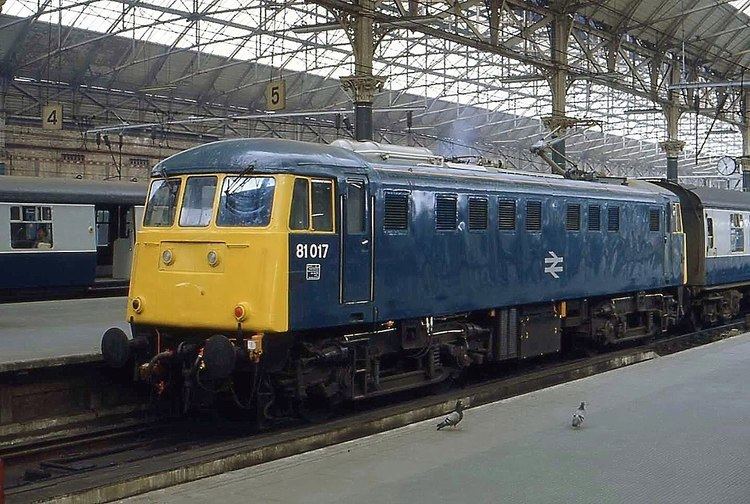Power type Electric Total produced 25 AAR wheel arr. B-B | Build date 1959–1964 | |
 | ||
Builder Associated Electrical Industries at Birmingham Railway Carriage and Wagon Company | ||
The British Rail Class 81 is an AC electric locomotive that formerly operated on the West Coast Main Line of the London Midland Region of British Rail. Originally designated AL1, it was the first type of AC electric locomotive to be delivered to British Railways.
Contents
History
As part of the modernization of the West Coast Main Line which included electrification, 100 locomotives of five types were acquired, each type from a different manufacturer.
The first locomotives to be delivered were of type AL1 designed by British Thomson-Houston (BTH), an order being placed for 25 examples. Of these, 23 were for use on passenger trains with a top speed on 100 mph and were designated Type A. The two remaining locomotives were to be for use on freight trains with a top speed of 80 mph, and were designated Type B.
Before the work was completed, BTH amalgamated with Metropolitan Vickers to form AEI (Associated Electrical Industries) traction division, and it was under this name that the locomotives were built in 1959 under subcontract by Birmingham Railway Carriage & Wagon in Smethwick. The first engine, number E3001, was handed over to British Railways on 27 November 1959. The type was initially used for crew training on the Styal Line between Manchester and Crewe.
The AL1 were numbered E3001 - E3023 and E3096 / E3097; The first twenty-three were Type A, while the last two were to have been the Type Bs and numbered E3301 and E3302. However the last two were instead geared for passenger service, being delivered in February 1964 as E3096 and E3097.
Power supply
The locomotives always worked on power provided by overhead catenary energized at 25,000 V AC. However, the main transformer, normally operated with the four windings in series, could be operated at 6250V AC with the transformer windings in parallel. This voltage was initially to be used where limited clearances gave concern over use of the higher voltage. However, this approach was never used on the West Coast main line, although it was employed elsewhere such as Glasgow Central in the initial 'Blue Train' electrification there. By the time the WCML wiring was extended to Glasgow, it had been revised there to the mainstream 25kV voltage.
Operations
Because they were restricted to those lines electrified at 25 kV AC they only operated on the West Coast Main Line. Cities where these engines could be seen included London, Birmingham, Manchester, Liverpool, and Glasgow. They operated passenger trains, freight trains, and parcel trains. There is no record of operation on the Ex-Great Eastern line, which was being electrified at the time of their introduction, nor subsequently on the East Coast Main Line (ECML) when that was electrified in the 1980s.
Early withdrawals
Three locomotives, E3002, E3009, and E3019, were withdrawn before they could be renumbered under the TOPS system. E3002 and E3019 were damaged by fire and both were scrapped at British Rail Crewe Works. The remains of E3009 were also cut up at Crewe Works following an accident in 1968.
Renumbering
Under the TOPS system, twenty-two examples were reclassified as class 81 and numbered 81001 - 81022.
Accidents and incidents
In addition to the three examples withdrawn before renumbering under TOPS others were withdrawn as a result of damage after being renumbered.
The end
Over the years examples of this class were withdrawn from service. The final examples were used for the transfer of empty coaches between London Euston Station and Willesden sidings between 1989 and 1991. The last two examples withdrawn from service were 81012 and 81017.
The majority of the class were scrapped at Coopers Metals in Sheffield.
Preservation
One example, 81002, has been preserved by the AC Locomotive Group, located at Barrow Hill Engine Shed.
